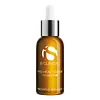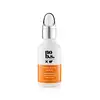What's inside
What's inside
 Key Ingredients
Key Ingredients

 Benefits
Benefits

 Concerns
Concerns

No concerns
 Ingredients Side-by-side
Ingredients Side-by-side

Water
Skin ConditioningAscorbic Acid
AntioxidantLaureth-4
EmulsifyingAlcohol Denat.
AntimicrobialPentylene Glycol
Skin ConditioningPropylene Glycol
HumectantTriethanolamine
BufferingTocopherol
AntioxidantGlycerin
HumectantBioflavonoids
Skin ConditioningRetinol
Skin ConditioningOlea Europaea Leaf Extract
PerfumingZinc Sulfate
AntimicrobialPolyporus Umbellatus Extract
Skin ProtectingArbutin
AntioxidantPolysorbate 20
EmulsifyingPhenoxyethanol
PreservativeWater
Skin ConditioningPropanediol
SolventSodium Ascorbyl Phosphate
AntioxidantGlycerin
HumectantTocopheryl Acetate
AntioxidantTetrahexyldecyl Ascorbate
AntioxidantSodium Hyaluronate
HumectantVaccinium Angustifolium Fruit Extract
Skin ProtectingCamellia Sinensis Leaf Extract
AntimicrobialCentella Asiatica Extract
CleansingGlycyrrhiza Glabra Root Extract
BleachingPunica Granatum Fruit Extract
AntioxidantFerulic Acid
AntimicrobialXanthan Gum
EmulsifyingDecyl Glucoside
CleansingHydroxyethylcellulose
Emulsion StabilisingArginine
MaskingCitric Acid
BufferingPhenoxyethanol
PreservativeEthylhexylglycerin
Skin ConditioningWater, Propanediol, Sodium Ascorbyl Phosphate, Glycerin, Tocopheryl Acetate, Tetrahexyldecyl Ascorbate, Sodium Hyaluronate, Vaccinium Angustifolium Fruit Extract, Camellia Sinensis Leaf Extract, Centella Asiatica Extract, Glycyrrhiza Glabra Root Extract, Punica Granatum Fruit Extract, Ferulic Acid, Xanthan Gum, Decyl Glucoside, Hydroxyethylcellulose, Arginine, Citric Acid, Phenoxyethanol, Ethylhexylglycerin
 Reviews
Reviews

Ingredients Explained
These ingredients are found in both products.
Ingredients higher up in an ingredient list are typically present in a larger amount.
Glycerin is already naturally found in your skin. It helps moisturize and protect your skin.
A study from 2016 found glycerin to be more effective as a humectant than AHAs and hyaluronic acid.
As a humectant, it helps the skin stay hydrated by pulling moisture to your skin. The low molecular weight of glycerin allows it to pull moisture into the deeper layers of your skin.
Hydrated skin improves your skin barrier; Your skin barrier helps protect against irritants and bacteria.
Glycerin has also been found to have antimicrobial and antiviral properties. Due to these properties, glycerin is often used in wound and burn treatments.
In cosmetics, glycerin is usually derived from plants such as soybean or palm. However, it can also be sourced from animals, such as tallow or animal fat.
This ingredient is organic, colorless, odorless, and non-toxic.
Glycerin is the name for this ingredient in American English. British English uses Glycerol/Glycerine.
Learn more about GlycerinPhenoxyethanol is a preservative that has germicide, antimicrobial, and aromatic properties. Studies show that phenoxyethanol can prevent microbial growth. By itself, it has a scent that is similar to that of a rose.
It's often used in formulations along with Caprylyl Glycol to preserve the shelf life of products.
Water. It's the most common cosmetic ingredient of all. You'll usually see it at the top of ingredient lists, meaning that it makes up the largest part of the product.
So why is it so popular? Water most often acts as a solvent - this means that it helps dissolve other ingredients into the formulation.
You'll also recognize water as that liquid we all need to stay alive. If you see this, drink a glass of water. Stay hydrated!
Learn more about Water